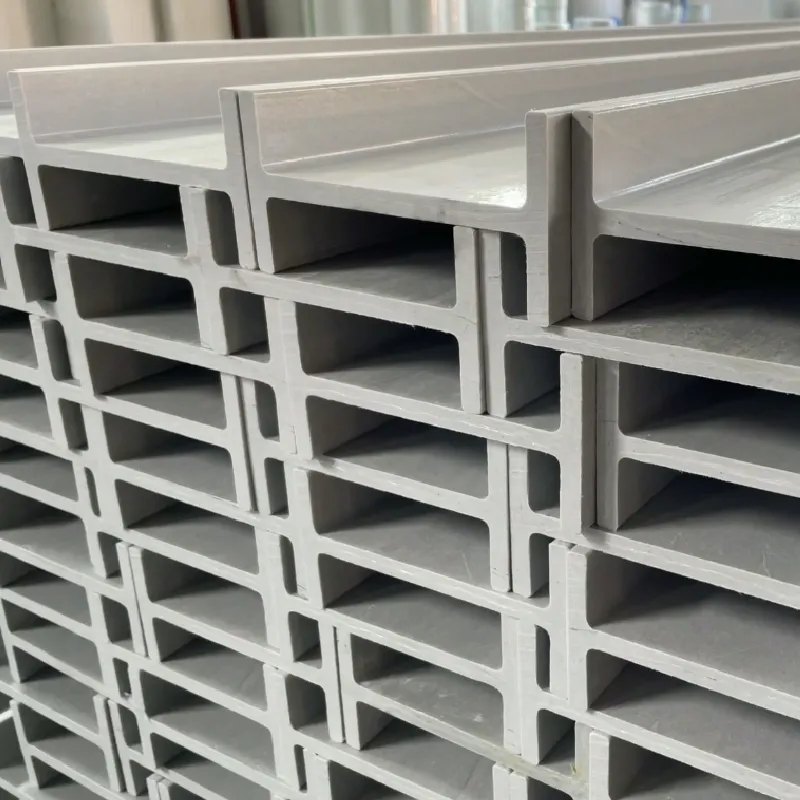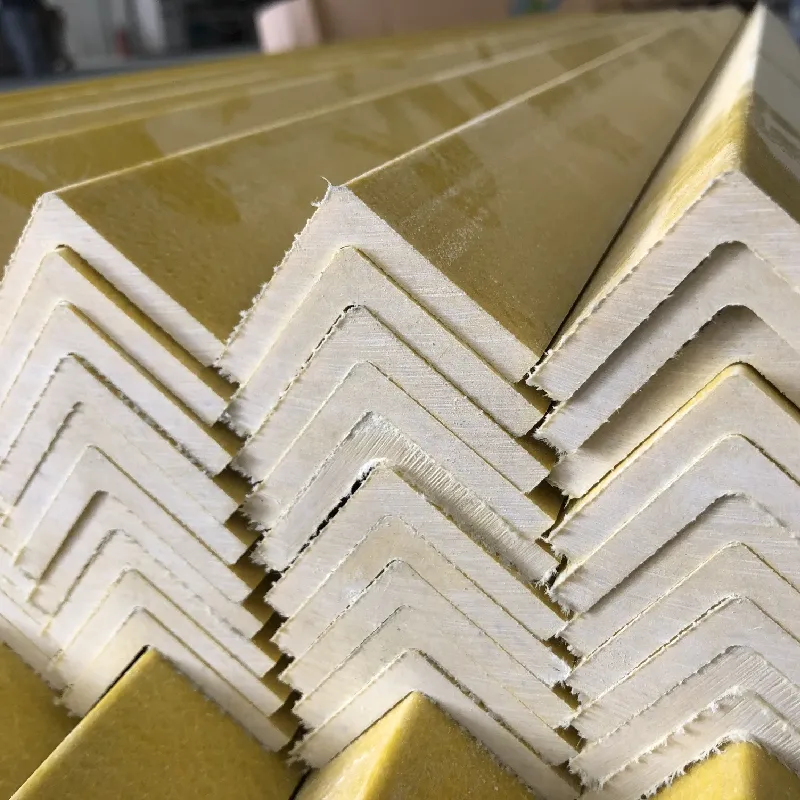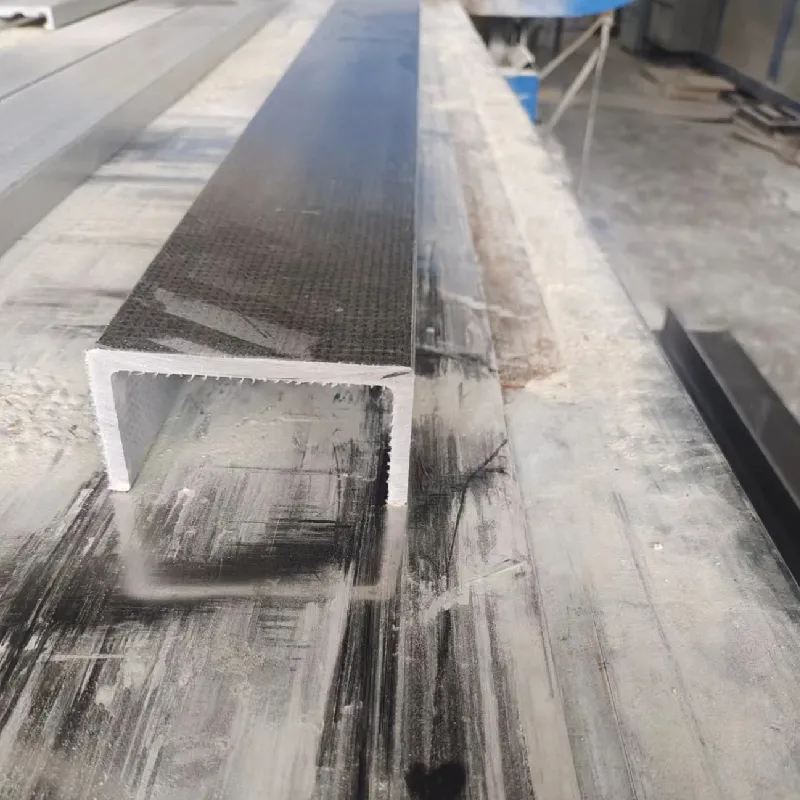loading...
- No. 9, Xingyuan South Street, Dongwaihuan Road, Zaoqiang County, Hengshui, Hebei, China
- admin@zjcomposites.com
- +86 15097380338
- Welcome to visit our website!
High Strength FRP Profiles for Construction & Industrial Use
FRP profiles (Fiber Reinforced Polymer profiles) are revolutionizing the materials engineering and construction industries, providing lightweight, high-strength, and corrosion-resistant solutions across a wide range of applications. In this guide, we delve deep into the latest trends, technical parameters, comparative data, fabrication process, and prominent use cases, focusing on the premium product: High Strength FRP Pultruded Profile Fiberglass I Beam for Construction.
Industry Overview & Market Trends
- 2024 Market Size: Global FRP profiles market valued at $3.7 billion, CAGR of 8.6% (2023-2027).
- Leading Applications: Construction, Water Treatment, Chemical Processing, Energy, Transportation, Aerospace.
- Key Drivers: Corrosion resistance, high strength-to-weight ratio, long service life, reduced maintenance.
- Top Standards: ISO 9001/14001, ASTM D638, EN 13706, ANSI/AWWA C950.
- Typical Forms: I-beams, C-channels, angles, tubes, custom profiles.

What are FRP Profiles?
FRP profiles are composite material shapes produced using high-performance fiberglass reinforced with polymer resins. Unlike steel or aluminum, these profiles provide unparalleled advantages in environments demanding longevity, chemical stability, and low weight. This makes them ideal for modern infrastructure and industrial projects, especially where durability and safety are critical.
- Material Composition: High-tensile E-glass fibers + unsaturated polyester/epoxy/vinyl ester resin matrices.
- Manufacturing Process: Pultrusion, a continuous automatic process ensuring consistent cross-section and properties.
- Industry Compliance: All leading manufacturers follow ISO, ASTM, and EN standards for quality assurance.
- Product Example: High Strength FRP I Beam
Technical Parameters Table: FRP Profiles vs. Traditional Materials
| Parameter | FRP Profiles | Steel | Aluminum | Wood |
|---|---|---|---|---|
| Density (g/cm³) | 1.7-2.0 | 7.85 | 2.7 | 0.6 |
| Tensile Strength (MPa) | 340-1200 | 400-550 | 130-400 | 60-100 |
| Elastic Modulus (GPa) | 20-50 | 200 | 70 | 10 |
| Corrosion Resistance | Excellent | Low | Moderate | Poor/Moderate |
| Service Life (years) | >50 | 30-40 | 20-30 | 10-15 |
| Conductivity | Insulator | High | Medium | Low |
| Fire Rating (EN 13501) | B-s2,d0 - Bfl-s1 | A1 | A1 | D/E |
Pultrusion Process: FRP Profile Manufacturing Workflow

- Fiberglass Roving Supply: High-tensile E-glass fibers are held on creels for continuous drawing.
- Resin Impregnation: Fibers are saturated in a thermo-set resin bath (polyester/epoxy/vinyl ester) including catalysts and additives for UV/fire/corrosion-resistance.
- Pre-Forming: Wet-out fibers are shaped via guides and rollers to the desired profile geometry (I-beam, channel, etc.).
- Pultrusion Die: Profile is pulled through a heated steel die (optimized via CFD/FEA simulations), initiating polymerization and achieving final cross-section dimension.
- Curing & Cutting: Cured continuous profile is automatically cut to required lengths with precise CNC saws.
- Quality Inspection: Nondestructive testing (NDT), dimensional and surface inspection as per ISO/ASTM/EN standards.
- Testing Standards: ISO 9001:2015, ISO 14001, ASTM D2344, EN 13706, ANSI/AWWA C950 for mechanical, physical & durability testing.
- Typical QC Data: Ultimate Tensile Strength (UTS): >600 MPa | Flexural Modulus: 23-30 GPa | Dimensional Tolerance: ±0.5 mm/m
High Strength FRP Pultruded I Beam: Product Specification

| Parameter | Unit | Value | |
|---|---|---|---|
| Type | - | Pultruded Fiberglass I Beam | |
| Material | Reinforcement | - | E-glass |
| Resin | - | Isophthalic polyester / Vinyl ester | |
| Standard Size | mm | 100 × 50 × 6 (customizable) | |
| Tensile Strength | MPa | ≥500 | |
| Flexural Strength | MPa | ≥600 | |
| Elastic Modulus | GPa | ≥25 | |
| Density | g/cm³ | 1.85-2.1 | |
| Water Absorption | % (24h) | <0.5 | |
| Fire Resistance | EN 13501 | B-s2,d0 | |
| Colors | - | Yellow/Gray/Custom | |
| Service Life | Years | >50 | |
Comparative Visualization: FRP I Beam vs. Competitors
Application Scenarios & Industry Advantages
- Stone, Oil & Gas: Acid-resistant walkways, platforms, handrails in refineries and chemical plants.
- Automotive & Rail: Battery trays, cable ladders, structural frames that demand EMI shielding and lightweight.
- Water & Wastewater: Non-metallic trench gratings, bridge beams, chlorination decks for maximum anti-corrosion.
- Construction: Building frames, roof supports, curtain wall skeletons—resistant to weather and fire regulations.
- Public Infrastructure: Railway sleepers, dock structures, cooling towers, marine fencing.
Why Choose This Supplier?
(EEAT Authoritativeness & Trustworthiness)
- Certified Excellence: Products conform with ISO 9001, EN 13706, ASTM D638 and pass SGS environmental testing.
- Industry Partnerships: Supplier for Fortune 500 construction groups, oil & gas leaders, and governmental water boards.
- Experience: 18+ years in pultrusion technology, exporting to 45+ countries with FRP profiles installed globally.
- Customization: Rapid prototyping, OEM/ODM, on-site technical support and engineering consultancy available.
- Warranty & Service: Up to 20 years product warranty, ISO-certified after-sales system, 24h technical response.
Customization & Engineering Support
- Profile Dimensions: Any cross-section and thickness, including solid and hollow core shapes.
- Resin System Optimization: Offerings in fire-retardant, UV-resistant, FDA-compliant (for water/food) formulations.
- Color & Surface: RAL palette, anti-slip, matte/glossy, logo printing.
- Pre-fabrication: CNC hole drilling, notching, assembly for direct site installation.
FRP Profiles FAQ – Specialist FAQ
- 1. What are the standard fiber types used in FRP profiles?
- Answer: The most common is E-glass, known for its high tensile strength and affordability. S-glass and carbon fibers can be used for higher-performance requirements.
- 2. How do you specify mechanical properties such as modulus and shear strength?
- Answer: Mechanical parameters are determined following EN 13706 and ASTM D638 methods. Typical elastic modulus values range from 20 to 50 GPa, with shear strength exceeding 80 MPa.
- 3. What installation standards should be followed?
- Answer: Use ISO 1461, ASTM D4097 and local building codes for structural design. Pre-drilled profiles allow bolt or rivet connections; adhesives must comply with EN 301.
- 4. Can FRP profiles be used in food or potable water environments?
- Answer: Yes, when formulated with FDA-approved, BPA-free resin systems and demonstrated via EN 14350 migration tests.
- 5. What thicknesses and tolerances are available for custom profiles?
- Answer: Thickness: 2 mm to 20 mm; width/height up to 600 mm. Tolerances typically ±0.5 mm/m, achieved using CNC cutting and die calibration.
- 6. How is fire safety assured for FRP profiles in public infrastructure?
- Answer: Use of brominated or phosphorus-based fire retardant additives enables ratings of B-s2,d0 (EN 13501). Smoke and toxicity tests are standard per ASTM E662.
- 7. What non-destructive testing (NDT) methods are applied?
- Answer: Ultrasonic pulse echo, X-ray tomography, and microscopy are employed for in-process and batch conformance checks according to ISO 21457 and ASTM D2563.
Worldwide Customer Feedback & Real Use Cases
“Excellent durability in high-salinity and acidic vapor zones. After 4 years, no visible surface degradation or strength loss. Fast installation by our local teams. Highly recommended!”
“Switched from steel to FRP profiles for bridge decks and ladders. Lower lifecycle costs and no rusting!”
“Compliant with strict hygiene standards (FDA/ISO), easy to clean, and maintains structural integrity in extreme temperatures.”
Guarantee, Certificate, and Customer Support
- Quality warranty: 20 years (material and workmanship defects)
- Third-party inspection: Accept SGS, BV, Intertek reports before shipping
- Technical support: Project design, on-site supervision, trouble-shoot, 24/7 online
- Document support: ISO, CE, EN, ASTM, FDA certifications provided
- After-sales: Spare parts, replacement within 48 hours globally
Contact us for engineering drawings, compliance dossiers, and free prototype samples!
- Advanced Composites Forum – Structural FRP Design Trends. CompositesWorld.com
- "Pultruded FRP Profiles – Mechanical Properties and Durability" (2023), Composites Science and Technology
- "FRP for Urban Infrastructure" – Discussion Thread, Engineering Tips Forum
- Global Market Report (2024), MarketsAndMarkets.com
-
The Rise of FRP Profiles: Strong, Lightweight, and Built to LastNewsJul.14,2025
-
SMC Panel Tanks: A Modern Water Storage Solution for All EnvironmentsNewsJul.14,2025
-
GRP Grating: A Modern Solution for Safe and Durable Access SystemsNewsJul.14,2025
-
Galvanized Steel Water Tanks: Durable, Reliable, and Ready for UseNewsJul.14,2025
-
FRP Mini Mesh Grating: The Safer, Smarter Flooring SolutionNewsJul.14,2025
-
Exploring FRP Vessels: Durable Solutions for Modern Fluid HandlingNewsJul.14,2025
-
GRP Structures: The Future of Lightweight, High-Performance EngineeringNewsJun.20,2025
